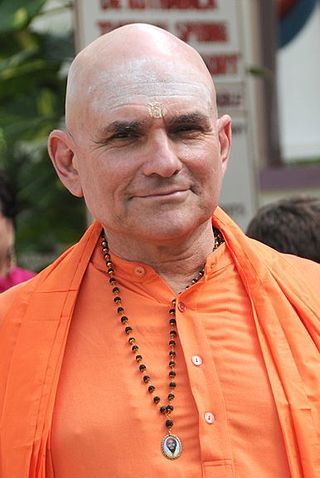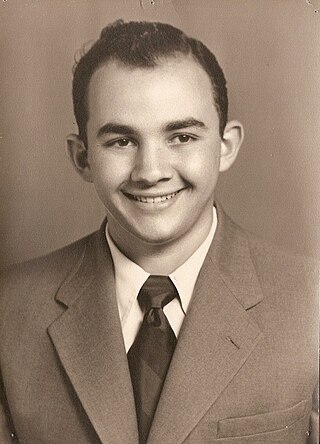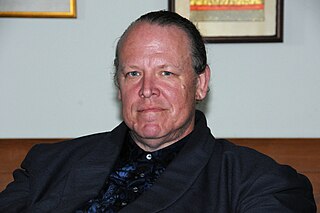
In Hinduism, Kundalini is a form of divine feminine energy believed to be located at the base of the spine, in the muladhara. It is an important concept in Śhaiva Tantra, where it is believed to be a force or power associated with the divine feminine or the formless aspect of the Goddess. This energy in the body, when cultivated and awakened through tantric practice, is believed to lead to spiritual liberation. Kuṇḍalinī is associated with Parvati or Adi Parashakti, the supreme being in Shaktism; and with the goddesses Bhairavi and Kubjika. The term, along with practices associated with it, was adopted into Hatha yoga in the 9th century. It has since then been adopted into other forms of Hinduism as well as modern spirituality and New age thought.

Swami Muktananda Paramahamsa, born Krishna Rai, was a yoga guru and the founder of Siddha Yoga. He was a disciple of Bhagavan Nityananda. He wrote books on the subjects of Kundalini Shakti, Vedanta, and Kashmir Shaivism, including a spiritual autobiography entitled The Play of Consciousness. In honorific style, he is often referred to as Swami Muktananda, or Baba Muktananda, or in a familiar way just Baba.
Soham or Sohum is a Hindu mantra, meaning "I am He/She/That" in Sanskrit.

Siddha Yoga is a spiritual path founded by Swami Muktananda (1908–1982). The organization states in its literature that the Siddha Yoga tradition is "based mainly on eastern philosophies". It also states that it "draws many of its teachings from the Indian yogic texts of Vedanta and Kashmir Shaivism, the Bhagavad Gita and the poet-saints." The present head of Siddha Yoga is Gurumayi Chidvilasananda.

Sivananda Saraswati was a yoga guru, a Hindu spiritual teacher, and a proponent of Vedanta. Sivananda was born in Pattamadai, in the Tirunelveli district of Tamil Nadu, and was named Kuppuswami. He studied medicine and served in British Malaya as a physician for several years before taking up monasticism.
Gurumayi Chidvilasananda, born Malti Shetty on 24 June 1955, is the guru or spiritual head of the Siddha Yoga path, with ashrams in India at Ganeshpuri and the Western world, with the headquarters of the SYDA foundation in South Fallsburg, New York.

Amrit Desai is a pioneer of yoga in the West, and one of the few remaining living yoga gurus who originally brought over the authentic teachings of yoga in the early 1960s. He is the creator of two brands of yoga, Kripalu Yoga and I AM Yoga, and is the founder of five yoga and health centers in the US. His yoga training programs have reached more than 40 countries worldwide and over 8,000 teachers have been certified.

Hindu Guru Nityananda was an Indian guru. His teachings are published in the "Chidakash Gita". Nityananda was born in Koyilandy (Pandalayini), Madras Presidency, British India.

Shree Muktananda Ashram, in the Catskills area of upstate New York, is owned and operated by the SYDA Foundation. Its purpose is to provide a location where students of Siddha Yoga can study the philosophy and culture of the Siddha Yoga path and follow its daily practices. Shree Muktananda Ashram houses the headquarters of the SYDA Foundation, the organization that protects, preserves, and facilitates the dissemination of the Siddha Yoga teachings. The ashram is located in South Fallsburg, approximately 130 kilometres north-west of New York City.
Gurudev Siddha Peeth is an Indian ashram run by the Gurudev Siddha Peeth Trust and serving the Siddha Yoga path. It is situated between the villages of Ganeshpuri and Vajreshwari in the state of Maharashtra, 70 miles (110 km) north-east of Mumbai. On the Siddha Yoga path it is known as the "mother ashram" because it is where Siddha Yoga began.

Mahamandaleshwar Swami Shankarananda is an American-born yoga guru in the lineage of Bhagavan Nityananda of Ganeshpuri. Swami Shankarananda is the author of several books on meditation and the philosophy and practice of Kashmir Shaivism. He emphasises spiritual practice (Sadhana), especially meditation, mantra and Self-inquiry. In Australia he founded a residential spiritual school in Australia, now called The Ashram Mount Eliza where about 20 seekers live and members of the wider public visit for programs, retreats and courses. Since 2015, there have been repeated allegations of coercive "secret sexual relations" between Shankarananda and women in the ashram community.

Rudi, born Albert Rudolph, also known as Swami Rudrananda, was born in Brooklyn, New York. Rudi was a spiritual teacher and an antiquities entrepreneur in New York City.

Mark Griffin was an American spiritual teacher in the lineage of Bhagawan Nityananda. Griffin was an author on the philosophy and practice of Yoga Tantra. He emphasizes spiritual practice (sadhana), especially meditation. He was the founder and director of Hard Light Center of Awakening, a Los Angeles-based spiritual school that, according to its literature, offers intensive training in meditation and other practical techniques of Enlightenment. He was also an artist.
Aghor Yoga is a spiritual tradition that originated in Northern India around the 11th Century C.E. The word Aghor literally means "that which is not difficult or terrible"; according to its adherents, Aghor is a simple and natural state of consciousness, in which there is no experience of fear, hatred, disgust or discrimination. Accordingly, believers contend that any time that humans experience a state of discrimination, we limit our wholeness and fall prey to disruptive emotions such as anger, fear, jealousy, greed, and lust. The practices of Aghor Yoga today reflect reforms made in the 1960s, shifting the focus of Aghor to seeking a balanced life of selfless service and personal practice. Baba Bhagwan Ramji encouraged the practitioners of Aghor to follow the vamachara by embracing socially stigmatized and neglected people, such as street children and people with leprosy and other "untouchable" diseases. Today, the followers of Aghoreshwar Bhagwan Ramji have established a large network of schools, orphanages, medical clinics, or other social service projects.

Sivananda Radha Saraswati, born Sylvia Demitz, was a German yogini who emigrated to Canada and founded Yasodhara Ashram in British Columbia. She established a Western-based lineage in the Sivananda tradition and published books on several branches of Yoga, including Kundalini Yoga for the West and Mantras; Words of Power. She was a member of the California Institute of Transpersonal Psychology and developed transpersonal psychology workshops to help students prepare for intense spiritual practice. Teachers trained at Yasodhara Ashram can now be found across North America and in Europe, the Caribbean, Japan, Australia and New Zealand.
Integral Yoga is a system of yoga that claims to synthesize six branches of classical Yoga philosophy and practice: Hatha, Raja, Bhakti, Karma, Jnana, and Japa yoga. It was brought to the West by Swami Satchidananda, the first centre being founded in 1966. Its aim is to integrate body, mind, and spirit, using physical practices and philosophical approaches to life to develop the physical, emotional, intellectual, and spiritual aspects of individuals. The system includes the practices of asana, pranayama, and meditation to develop physical and mental stillness so as to access inner peace and joy, which Satchidananda believed was a person's true nature. It also encourages practitioners to live service-oriented lives.

Yoga tourism is travel with the specific purpose of experiencing some form of yoga, whether spiritual or postural. The former is a type of spiritual tourism; the latter is related both to spiritual and to wellness tourism. Yoga tourists often visit ashrams in India to study yoga or to be trained and certified as yoga teachers. Major centres for yoga tourism include Rishikesh and Mysore.

Modern yoga gurus are people widely acknowledged to be gurus of modern yoga in any of its forms, whether religious or not. The role implies being well-known and having a large following; in contrast to the old guru-shishya tradition, the modern guru-follower relationship is not secretive, not exclusive, and does not necessarily involve a tradition. Many such gurus, but not all, teach a form of yoga as exercise; others teach forms which are more devotional or meditational; many teach a combination. Some have been affected by scandals of various kinds.

Adi Da Samraj, born Franklin Albert Jones was an American-born spiritual teacher, writer and artist. He was the founder of a new religious movement known as Adidam.












